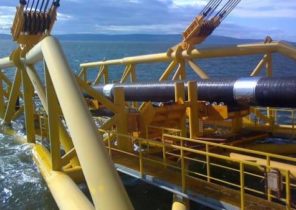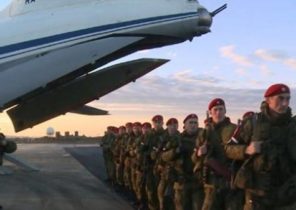
From the blog WarIsBoring
The American fighter F-22 Raptor is one of the most modern combat aircraft in the world. However, it has several weaknesses. For example, he sees nothing in the infrared range, although some of his potential opponents have infrared sensors detect and track (IRST), which actually allows them to detect heat signatures of enemy warplanes.
Last of the American fighters, which is still in the process of finishing has installed infrared sensors detect and track, was the F-14 Tomcat. On the F/A -18 Super Hornet can be installed outboard of the Central container with the infrared sensors detection and tracking, however, drop them in battle makes this option expensive.
The F-22 also lacks the radar side-view, allowing combat aircraft to shoot a missile to be corrected halfway toward the goal with the plane’s radar and continue data transfer support after the rejection of more than 90 degrees off course rocket.
Without such a radar, the fighter will be forced to maintain a policy of rapprochement with the enemy plane to get close this way with any enemy missile that can be launched by the enemy.
The reason for such disadvantage is connected with that period when he developed the F-22 Raptor.
Development of the F-22 began in 1981 in the framework of the program for the development of advanced tactical fighter. Air force the United States placed in the companies General Dynamics and McDonnell Douglas contracts for the initial development of attack aircraft, capable of flying at a speed of 2.5 Mach at high and medium altitudes and to carry on Board weapons used out of range of air defenses, and destroy tanks and other ground targets.
First, this program did not work, because the F-16 Fighting Falcon, originally designed as a fighter air combat in the daytime, came in through the back door and was reoriented to fill the role of attack aircraft and destroying ground targets.
In late 1985, the U.S. air force made a few changes in your requirements then the work on the program continued and at this stage more attention has been paid to reduced visibility. In addition, we have changed the selection process, and instead of providing $ 100 million in each of the four companies, it was decided to provide contracts for $ 700 million to two companies for the production of a flying prototype.
One of the prototypes must be equipped with engines Pratt & Whitney F119 and the other is a General Electric F120 engine. Around the same time, the leadership of the U.S. air force sent letters to rival firms in order to support the work within the team.
The idea was that the USAF wanted to get to work on such a large and costly program as much talent as possible. As a result, firms Boeing, Lockheed and General Dynamics formed one team, and Rockwell and Grumman joined the other.
31 October 1986, the USAF announced the winners of the competition at this stage of the programme for the development of advanced tactical fighter Lockheed and Northrop. Agreement on the formation of the team with participation of employees of the companies Boeing, General Dynamics and Lockheed called to the head of the team was the winning company, and therefore this role was taken on by Lockheed. The winning teams were given four years for the production of a flying prototype.
The project company Lockheed at this stage included the presence of a rotating bomb Bay, that forces them to push forward the engines and air intakes, and this, in turn, causes excessive impedance. That’s what happened with the F-35, developed the program of creation a unified strike fighter with its swivel nozzle for vertical takeoff, making the plane too broad and clumsy. Rotating nozzles for vertical takeoff is the original sin in the design of the F-35.
The USAF were initially required mainly located inside the fuselage compartment of the F-22 could accommodate eight missiles. But then their number was reduced to six, as both design teams have come to the conclusion that effective this solution can not be. At the same time were removed the requirements regarding reverser thrust, and it was done after it was determined that such opportunities are not worth the price you have to pay for the expense of General performance.
The main challenge of the F-22 was to integrate low visibility, supersonic cruising speed, highly integrated avionics and maneuverability in the aircraft greater range than the F-15 Eagle, which he had to replace. In addition, for reliability it must have been in twice to surpass the F-15, and maintenance requirements should have been halved. Although in practice over the past several years, the readiness of the F-22 was improved and approached the performance of the F-15, maintenance requirements had been higher by 50%.
A model of firm firms Lockheed and Northrop have wings diamond shape with a long root chord connecting them with the fuselage, which provides load distribution, and the presence of a greater number of jumpers that takes the bending load. Large wings allow to have a greater amount of fuel.
However, in January of 1989 the U.S. air force has limited the cost of the avionics of the F-22 ceiling to $ 9 million for one plane. At this point, a paper project of Lockheed planned to spend $ 16 million on the avionics for each aircraft.
From the systems of infrared detection and tracking had to be abandoned — as abandoned from a number of other systems, including mounted on the linear elements of the fuselage of the radar side-view.
Processing power electronics and the quality of the optics was increased in the last decade, and therefore the price of the airframe of the fighter were reduced. However, the reason that the F-22 has no infra-red detection systems and maintenance related to limiting costs, the avionics, introduced in 1989. USAF did not specify which system you had to sacrifice in order to meet the prescribed ceiling. The company decided that it would be better to do for the money. And 27 years later, the main competitor of the F-22 Russian su-35 Flanker-E has an infrared system detection and tracking, as well as additional radars in the linear elements of the fuselage.







